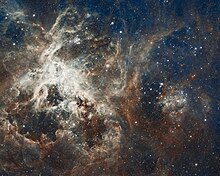Fichier:30 Doradus, Tarantula Nebula.jpg

Taille de cet aperçu : 749 × 599 pixels. Autres résolutions : 300 × 240 pixels | 600 × 480 pixels | 960 × 768 pixels | 1 280 × 1 024 pixels | 2 560 × 2 048 pixels | 20 323 × 16 259 pixels.
Fichier d’origine (20 323 × 16 259 pixels, taille du fichier : 99,35 Mio, type MIME : image/jpeg)
Historique du fichier
Cliquer sur une date et heure pour voir le fichier tel qu'il était à ce moment-là.
| Date et heure | Vignette | Dimensions | Utilisateur | Commentaire | |
|---|---|---|---|---|---|
| actuel | 8 juillet 2012 à 19:35 |  | 20 323 × 16 259 (99,35 Mio) | Prof. Professorson | Higher resolution, converted from http://spacetelescope.org/static/archives/images/original/heic1206a.tif. |
| 19 avril 2012 à 13:13 |  | 2 340 × 1 847 (2,52 Mio) | Dipankan001 |
Utilisation du fichier
La page suivante utilise ce fichier :
Usage global du fichier
Les autres wikis suivants utilisent ce fichier :
- Utilisation sur af.wikipedia.org
- Utilisation sur arc.wikipedia.org
- Utilisation sur ar.wikipedia.org
- Utilisation sur be-tarask.wikipedia.org
- Utilisation sur bn.wikipedia.org
- Utilisation sur crh.wikipedia.org
- Utilisation sur cs.wikipedia.org
- Utilisation sur cv.wikipedia.org
- Utilisation sur de.wikipedia.org
- Utilisation sur en.wikipedia.org
- Tarantula Nebula
- Starburst region
- Talk:Tarantula Nebula
- Wikipedia:WikiProject Astronomy/Recognized content
- Wikipedia:Featured pictures/Space/Looking out
- User:North8000
- Wikipedia:Teahouse/Guests
- Wikipedia:Teahouse/Guest profile summary
- Wikipedia:Teahouse/Guest profile summary/Avatars
- Wikipedia:Teahouse/Guests/Left column
- Wikipedia:Teahouse/Guests/Right column
- User:The Determinator/Userpage/Top/Image
- Wikipedia:WikiProject Astronomy/Recognized astronomy content
- Wikipedia:Teahouse/Guest book/Archive 7
- Wikipedia:Teahouse/Guest book/Archive 10
- Wikipedia:Teahouse/Guest/Featured/21
- Wikipedia:Teahouse/Guest/Featured/22
- Wikipedia:Teahouse/Guest book/Archive 13
- Wikipedia:Teahouse/Guest book/Archive 14
- Wikipedia:Teahouse/Guest book/Archive 15
- Wikipedia:Teahouse/Guest book/Archive 16
- Wikipedia:Teahouse/Guest book/Archive 17
- Wikipedia:Teahouse/Guest book/Archive 18
- Wikipedia:Teahouse/Guest book/Archive 19
- Wikipedia:Teahouse/Guest book/Archive 20
- Wikipedia:Teahouse/Guest book/Archive 21
- Wikipedia:Teahouse/Guest book/Archive 22
- Wikipedia:Teahouse/Guest book/Archive 23
- Wikipedia:Teahouse/Guest book/Archive 26
- Wikipedia:Teahouse/Guest book/Archive 28
- Wikipedia:Teahouse/Guest book/Archive 29
- Wikipedia:Teahouse/Guest book/Archive 30
- Wikipedia:Teahouse/Guest book/Archive 31
- Wikipedia:Teahouse/Guest book/Archive 34
- Wikipedia:Teahouse/Guest book/Archive 35
- Wikipedia:Teahouse/Guest book/Archive 36
- Wikipedia:Teahouse/Guest book/Archive 37
- Wikipedia:Teahouse/Guest book/Archive 39
- Wikipedia:Teahouse/Guest book/Archive 40
- User:LucasTichawa
Voir davantage sur l’utilisation globale de ce fichier.

